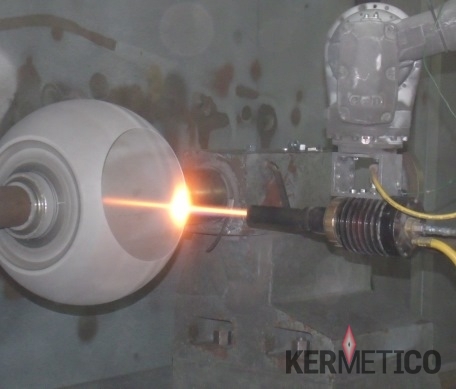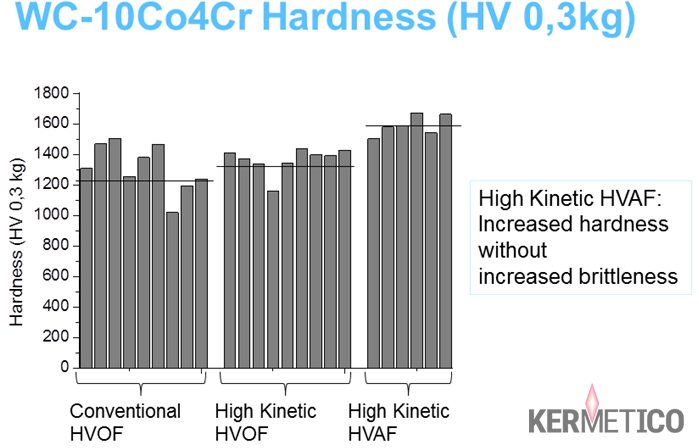WC-10Co-4Cr Tungsten Carbide Cobalt Chrome HVAF Thermal Spray Coating Properties, Structure And Applications
WC-CoCr 86/10/4 powder is used for the deposition of wear resistant coatings. Kermetico HVAF tungsten carbide coatings have excellent resistance to sliding wear, abrasion, cavitation, and erosion.
They are tough and reveal good fatigue and impact resistance, excellent corrosion resistance except in high pH environments and in hydrofluoric acid solutions.
Kermetico HVAF coatings are gas-tight (non-permeable to gas).
Tungsten Carbide WC-10Co-4Cr Powder Material Properties
Tungsten carbide coatings are sprayed mostly with WC-10Co-4Cr agglomerated and sintered powder
| Nominal composition | Wt.% |
|---|---|
| Tungsten carbide | Base |
| Total carbon | 5.3-5.4 |
| Cobalt | 9.5-10.5 |
| Chromium | 4.0-5.0 |
Powder products are available from some suppliers with compositions where cobalt is replaced partially with nickel.
The same WC-10Co-4Cr feedstock powder leads to different coating properties when deposited using different technologies. You can see these differences by looking at a hardness comparison chart made by VTT science center, Finland, above.
Why is that?
The plasma process had been used to spray tungsten carbide coatings before the introduction of the HVOF process, but the results were poor compared to today’s standards.
Although HVOF technology improved WC-coating properties substantially, noticeable material oxidation and WC decomposition still occur during HVOF deposition.
The oxidation results in coating embrittlement and subsequent reduction of its service lifetime in conditions of abrasive wear, erosion, and especially cavitation.
The embrittlement of WC-coatings is directly related to a high combustion temperature, usually more than 3000°C (5,432°F), as well as the presence of oxygen in the HVOF combustion products.
Thus, there is a need for spray equipment that operates at a much lower temperature while generating a higher particle velocity to compensate for the temperature reduction.
To meet that need we created a high-velocity air fuel (HVAF) system that uses gas fuel and compressed air for combustion at substantially lower temperatures and higher particle velocities.
Depositing WC-based coatings by the Kermetico HVAF spraying process not only eliminates the WC-coating embrittlement and improves its hardness and density but also reduces the production cost due to higher spray rates achieved and use of air instead of pure oxygen.
A distinguishing feature of the Kermetico HVAF process is that spray particles are heated but preferably not fused during spraying.
With the HVAF combustion temperature below 2,000oC (3,632°F), the surface temperature of cobalt, nickel and iron alloy particles usually remains near their melting point.
Herewith, the improved efficiency of the spray guns and ability to use smaller particle sizes results in achieving very high spray particle velocities, measured at 800-1,000+ m/s (2,6oo-3,300 ft./sec.)
Kermetico HVAF WC-Co-Cr Carbide Coating Properties
The table below describes properties of WC-10Co-4Cr coatings obtained by different Kermetico HVAF gun configurations.
| Property\Kermetico HVAF Spray Mode | Economy | Balanced | Ultra-quality |
|---|---|---|---|
| Deposit efficiency, % | 65+ | 48-58 | 36-42 |
| Hardness, HV300 | 1,050-1,250 | 1,250-1,350 | 1,350-1,600+ |
| Apparent metallographic porosity | <0.8 | <0.5 | <0.3 |
| Bond strength (@0.040” thickness), MPa (PSI) | 80+ (12,000+) | ||
| Typical as-sprayed roughness, micro-inch | 80-130 | ||
| Lowest as-sprayed roughness, micro-inch | N/A | 40 | 40 |
| Maximum working temperature, oF (oC) | 950 (510) | ||


